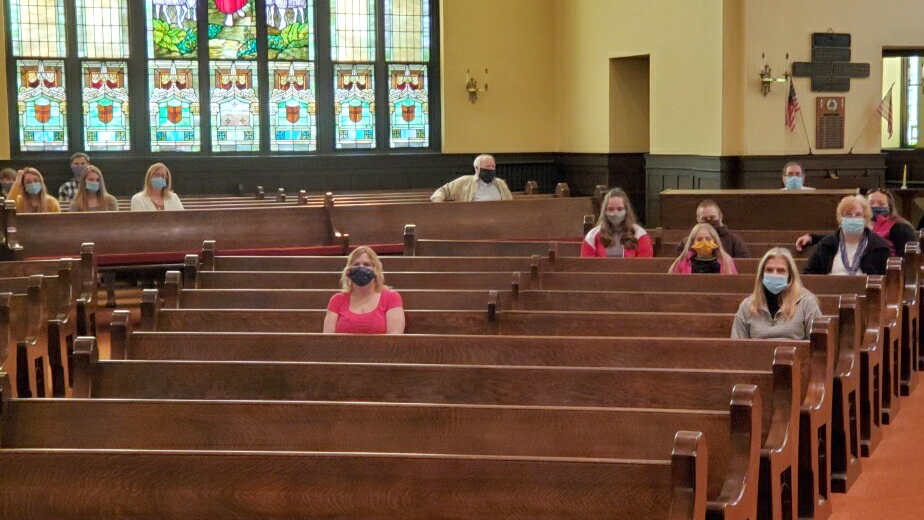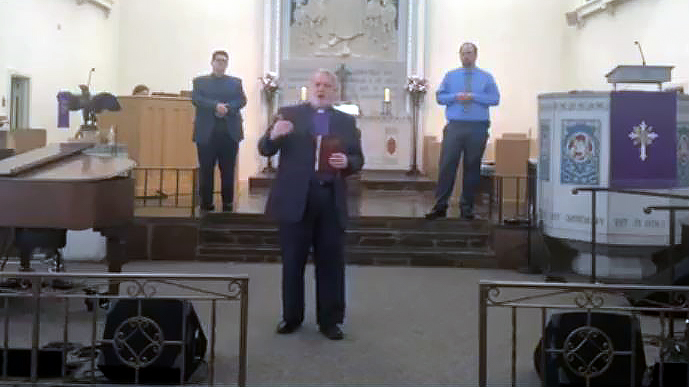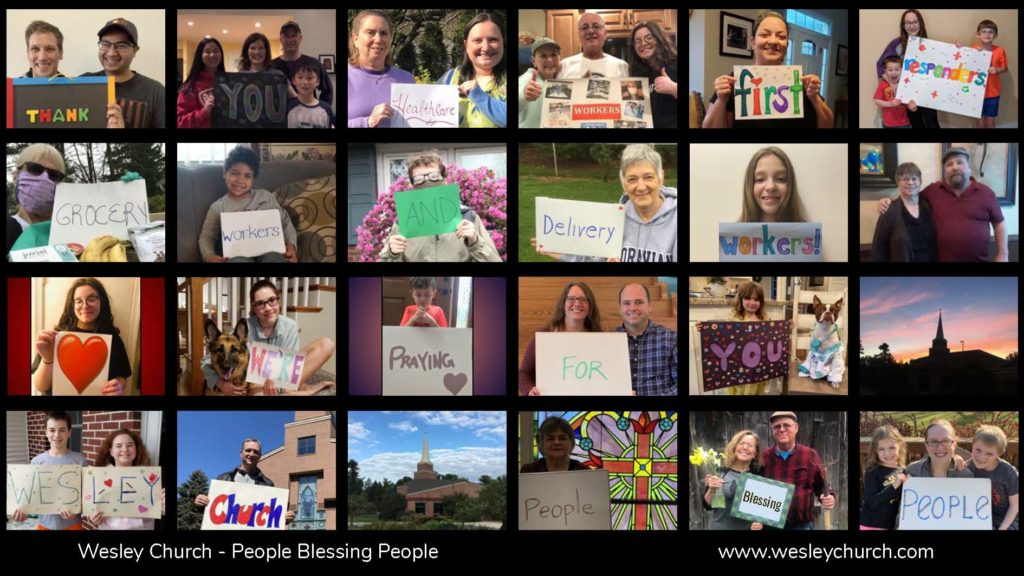
Members of First UMC Mt. Carmel (above) came home for Mother’s Day May 10. With bright carnations in hand, they returned to their beloved, historic sanctuary for worship after a two-month absence during the deadly COVID-19 pandemic that led to closed churches and stay-at-home orders from the state government.
“It felt good,” said the Rev. Kay Painter, pastor. “It did look strange with all our members wearing masks and sitting apart from each other. But it really didn’t feel strange because it was great to be there. And we’re still doing church!”
Other congregations in this northwesternmost region of the Eastern PA Conference have also returned or will return by June 7 to either their sanctuaries or church parking lots for onsite worship. They are in the less-populated Northumberland County, which is in Pennsylvania Governor Tom Wolf’s yellow-phase of pandemic mitigation efforts, meaning some relaxing of the extreme measures that shut down most businesses, services and public gatherings in late March.
Gatherings must still be limited to 25 participants, who wear protective face coverings and sit at least 6 feet from one another. Other restrictive protocols to avert COVID-19 infections include temperature checks for admittance, no use of hymnals or passing offering plates, and no singing by the congregation which can easily spread the virus.
Communion elements—wafers and juice—must come packaged together and be offered with no hands touching. And any fellowshipping must be done at a safe social distance. More detailed interaction and sanitation guidelines to protect public health are offered in a growing number of resources, including some that are accessible from the conference website’s Coronavirus Ministry Response page.
Meanwhile, most churches—even in the governor’s yellow phase of mitigation measures—are wary of reopening their sanctuaries too soon. And many say they will wait until their areas reach the green phase of readiness. Bishop Peggy Johnson has repeatedly advised such caution and told churches to reopen when they feel it is safe for their members.
“Reopening guidelines issued by the state and CDC (Centers for Disease Control and Prevention) are still our best practices,” she wrote in her latest episcopal letter to church leaders. “And they should be followed in the interest of health and safety for all, especially our older congregants and those with health issues that put them at higher risk.”
The bishop’s Cabinet advises every church’s board of trustees and pastors to draft reopening plans with safety guidelines in mind, including regular cleaning of their interiors and enabling hand sanitation wherever people gather. (See Pandemic Reopening Best Practices for Churches and Video: Cabinet explains church reopening guidelines in webinar.)
Churches urged to continue online ministry
Meanwhile, churches that have moved their worship, Christian education, meetings and other activities online are urged to continue doing that even after they are able to return to onsite gatherings. Whether they are using videoconferencing on Zoom or other platforms, webinars or livestream or recorded video—even telephone conference calls—such connective innovations should continue even when churches reopen.
“This action can accommodate those who are unable to come to the church in person,” said Bishop Johnson, “and it can further the church’s online outreach into the community.”

Indeed, it has done just that for many churches who testify to seeing both new faces and long-absent faces, along with phone numbers, onscreen in their virtual worship, Bible studies and prayer meetings. Many pastors say they and their members were not interested in doing church online until it first became a necessity and then a boon to their outreach.
“Our first week of services was viewed by over 1,000 people,” reported the Rev. Jim Anderman, lead pastor of First UMC Palymra, which began livestreaming its services via Facebook Live in March. “That means more people watched on Sunday than our average attendance.”
Some churches, especially in rural areas, have come together for joint livestreamed worship, a benefit for those that lack high-speed internet access or the capability to livestream. Anderman teams up and take turns preaching with the Revs. Jared Stoltzfus and Jason Armold, pastors of Bethany UMC Palmyra and Rocherty UMC Lebanon, respectively. And Grace-St. Paul’s UMC in Jim Thorpe livestreams worship on YouTube along with three nearby partner congregations.

“The church is always at its best when tested by the fires of adversity,” said Bishop Johnson. “These amazing pastors and their mighty lay people have taken a crisis and turned it into an opportunity to do much good and even greater works than before. I stand in awe of these creative, hardworking ministers of the Gospel.”
Indeed, virtual church is taking off big-time across our conference—not only in gatherings but also in giving.
More churches are trying to prevent or stem financial losses from not worshiping in their sanctuaries by turning to online giving, using a variety of apps. They are learning how to use—and convince tradition-bound members to use—Tithe-ly, Givelify, Venmo, Vanco, PayPal and other giving apps, as well as virtual banking solutions like Zelle.
Now the Eastern PA Conference is offering another offering-plate alternative to ease churches’ orientation into online giving. “In these changing times, we are pleased to offer an online giving option to aid local churches,” announced James Brown, conference Treasurer.
The conference activated a new service on its website’s Giving page in late May that allows members, visitors and donors to easily contribute online to congregations by selecting from a menu of participating churches.
The new giving portal, a benefit of the conference’s relationship with Vanco, is available to all churches; but it should be especially helpful to churches that do not currently offer online giving but want to. They must simply complete a bank electronic funds transfer form and return it to the conference’s accounting office, which will process and deposit gifts into the participating church’s designated bank account weekly.

No fees are charged to churches for the online giving set-up or transactions, thanks to the Mid-Atlantic United Methodist Foundation (MAUMF), which is paying the cost.
No doubt all of this new online connectivity will change and expand the ways many churches do church long after this pandemic crisis ends. It’s a virtual silver lining around the dark, ominous cloud that COVID-19 has cast over us.
And while these new virtual experiences may initially seem strange to many, eventually the unfamiliarity will disappear. And many will gratefully realize what Rev. Painter observed: “We’re still doing church!”
